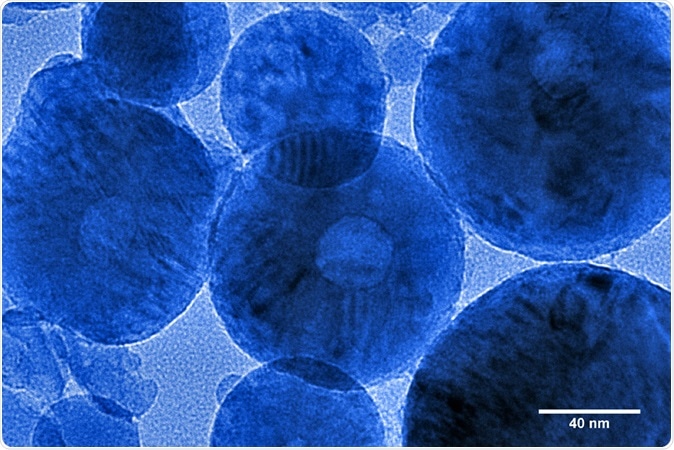A team of researchers from Mayo Clinic have found that that Titanium Dioxide (TiO2) nanoparticles that are present in bone implants may be causing harm by impairing bone formation and interfering with resorption at the site of repair. This can lead to loosening of the implants and pain.
The study report entitled, “Local Cellular Responses to Titanium Dioxide from Orthopedic Implants,” is published this week in the journal BioResearch Open Access. The team of researchers including Jie Yao, Eric Lewallen, David Lewallen, Andre van Wijnen belong to the Mayo Clinic, Rochester, MN and Second Affiliated Hospital of Soochow University, China.

Several Titanium nanoparticles as seen in Transmission Electron Microscope. Image Credit: Georgy Shafeev / Shutterstock
The team of researchers for their report first gathered the study results from the recently published studies where the effects of the titanium based implants on the bone cells and related cell types have been studied. They focussed on what effects the titanium dioxide nanoparticles were having on the behaviour as well as the viability of the bone cell and bone cell type of cells. Effects of different particle sizes, structures as well as their aggregations on the cells were noted. The effects within the cell (intracellular) as well as outside the cells (extracellular) were reported in these various studies. According to BioResearch Open Access Editor Jane Taylor, MRC Centre for Regenerative Medicine, University of Edinburgh, Scotland, and this article is a review of the other studies that look at the effects of these orthopaedic implants and their metallic components on the cells of the body. Given the large number of orthopaedic procedures using these implants each year, these effects are of great clinical interest she explained. The authors of the report also say that at present total joint arthroplasty (or joint replacement using metallic implants) is at 7 million in the United States and this is slated to rise in the near future. This review was supported by the National Institutes of Health.
The authors write that some of the common complications associated with total joint arthroplasty that require another operative procedure include infections of the joint as well as implant related problems such as dislocations of the joint, wear and tear of the residual bones, loosening of the implants etc. Studies have shown that 10 to 15 percent of patients turn up with these non infective causes of implant failure. They explain that most implants get corroded and with use wear and erode. To protect these, they are coated with a layer of particles called the surface oxide layer. With the friction between the surfaces, these layers too get eroded. This releases the harmful metallic particles that can enter the joint space as well as the surrounding tissues. This leads to loosening of the implants. Titanium dioxide (TiO2) particles come from the relatively harmless titanium alloys that are used to make these layers. These titanium dioxide particles are harmful to human cells.
The team reviewed several studies that showed that the size, shape and the structure of the nanoparticles were important in causing cellular damage at the joints. They found from various studies that these particles were taken up by the cells using a process of endocytosis.
One of the studies has noted that these TiO2 nanoparticles get coated with a biocomplex of calcium and phosphorus and other compounds such as glycoproteins. Then they enter the cells in a manner akin to “Trojan horses”. Once inside the TiO2 nanoparticles are released in the cell and they are free to cause damage. They can program the cells to undergo death in a process called apoptosis. This prevents further growth and repair of the damaged areas of the bones. These can all contribute to failure of the implants by loosening conclude the authors of the study.